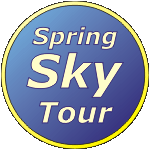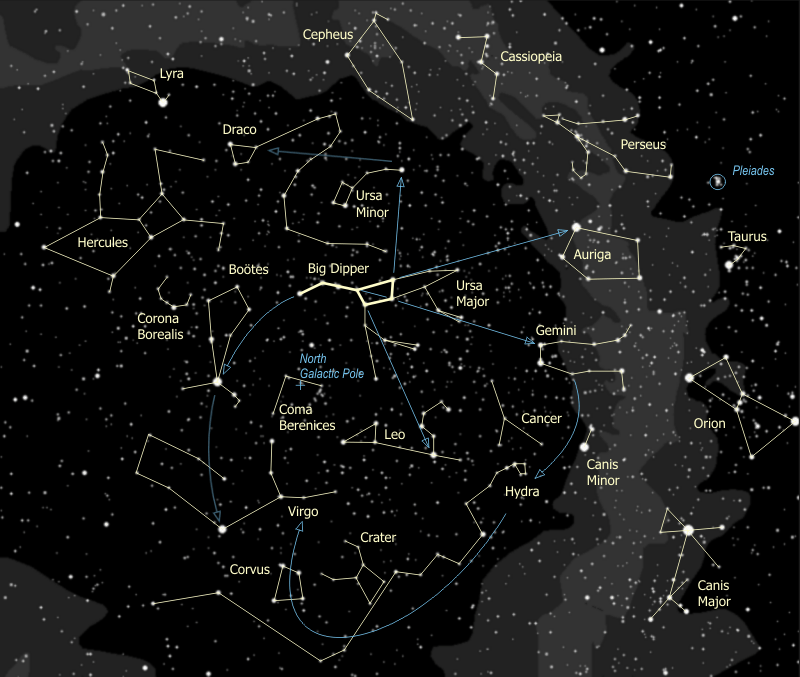Stargazing

|
Spring Sky Tour Home Page |

|
As the earth swings about the sun toward the northern face of our galaxy, we find ourselves looking out into deep space -- we are past the bright stars of winter into a fainter portion of the sky. With fewer bright stars, though, comes an abundance of deep sky beauties. If ever there is a time to bring out the largest aperture telescope you can get, the time is now.
The account here is the agenda that I loosely follow in providing a guided tour of the spring skies as visible from 45° North Latitude. This tour is designed for one topic to lead to the next, so it flows nicely and still manages to teach Astronomy under the night sky as we caravan from one constellation to another. Aside from the binoculars and telescopes I usually make a point of also bringing a highly focused flashlight which serves as an effective pointer for tracing out constellations.
View to the South

View to the North

Index to the Tour
![]() Retreat of the Winter Titans
Retreat of the Winter Titans
![]() Polar Constellations
Polar Constellations
![]() Auriga
Auriga
![]() Gemini & Cancer
Gemini & Cancer
![]() Hydra, Crater, & Corvus
Hydra, Crater, & Corvus
![]() Virgo
Virgo
![]() Bootes & Corona Borealis
Bootes & Corona Borealis
![]() Leo & Coma Berenices
Leo & Coma Berenices
Overview of the Tour
The Spring tour is unique, with the Big Dipper serving as the hub from which we guide our tour group through the entire parade of constellations. Starting with the pointer stars to Polaris, we then sweep generally West to East with the pointers to Auriga, then the pointers to Gemini then sweeping down through Hydra and Company to Virgo, then following the Dipper's handle (arc to Arcturus), and finishing with the pointers to Leo and Coma Berenices.
First, though, we will discuss the retreating winter titans -- Orion, Taurus, Canis Major, and Perseus. If they are fairly visible I might start with them, then go to the Big Dipper. This can be done in March and early April, although by May it's a lost cause. In particular -- I am trying to show off the Orion Nebula if looks reasonably good, as it is the last good diffuse nebula we will have until the Teapot of Sagittarius clears the trees.

The Top Attractions
Time might be limited, if it's chilly, if conditions are changing, or else if time is just limited. In that case, these are the best items to hit - the ones that the kids (and the adults) are talking about days later.
| Feature | Naked Eye | Binoculars | Telescope |
| Mizar & Alcor | ✔ | ✔ | |
| The Beehive | ✔ | ✔ | ✔ |
| The Lost Star Cluster (M48) | ✔ | ✔ | |
| The Eskimo Nebula | ✔ | ||
| Sombrero Galaxy | ✔ | ✔ | |
| Arcturus | ✔ | ||
| M53 | ✔ | ✔ | |
| Regulus & Gamma Leonis | ✔ | ✔ | ✔ |
| Black Eye Galaxy | ✔ | ✔ |
| Feature | Visual | Binocs | Scope |
| Mizar & Alcor | ✔ | ✔ | |
| The Beehive | ✔ | ✔ | ✔ |
| The Lost Star Cluster (M48) | ✔ | ✔ | |
| The Eskimo Nebula | ✔ | ||
| Sombrero Galaxy | ✔ | ✔ | |
| Arcturus | ✔ | ||
| M53 | ✔ | ✔ | |
| Regulus & Gamma Leonis | ✔ | ✔ | ✔ |
| Black Eye Galaxy | ✔ | ✔ |
 |
 |
| Back to Stargazing Home Page | On to Retreat of the Winter Titans |
Download This Tour
|
|
Spring Sky Tour in PDF | You can download this entire tour in a single PDF document. |

|
Spring Sky Tour in Word | You can download this entire tour in a single Word document. |
Links
 Goddard Space Flight Center Hubble Site
The best Hubble web site in my "hubble" opinion
Goddard Space Flight Center Hubble Site
The best Hubble web site in my "hubble" opinion
 The SEDS Messier Catalog -- a great reference for more information
and images of the Messier Catalog deep sky objects.
The SEDS Messier Catalog -- a great reference for more information
and images of the Messier Catalog deep sky objects.
 Views of the Solar System
Excellent reference on the solar system, well organized and packed with goodies.
Views of the Solar System
Excellent reference on the solar system, well organized and packed with goodies.
Questions
Your questions and comments regarding the Stargazing section are welcome.
You can e-mail the author, Randy Culp for inquiries,
suggestions, new ideas or just to chat.
Updated 18 July 2023
